Derby's Heritage Part 19 - Victoria St
w/e 31 July 2011
All this week's pictures were taken
with a Kodak DX6490
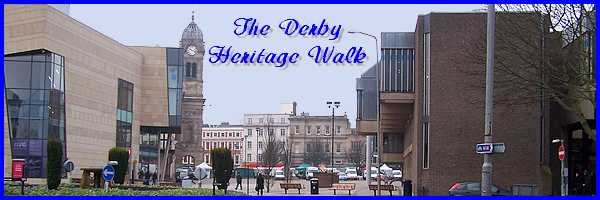
Our zig-zag route through central Derby that took
us along St James's Street in Part 18 continues in this part
as we return to the Corn Market but this time our way is along
Victoria Street. Victoria Street as we have already learned was
created when the Markeaton Brook was culverted, the work being
completed in 1837 and the street named in honour of Queen Victoria's
accession to the throne in the same year.

 Much of
the south side of the street was cleared in the early 1960s and
the URC that was incorporated into the new development became
the fourth chapel to stand on this site. Congregationalists have
worshipped here since 1783 following their formation in Derby
five years earlier. As part of that same 1962 development, Duckworth
Square, at the side of the URC (left), was created between Victoria
Street and Macklin Street. It was surrounded by a multi-storey
car park and the entrance was on the site of the former Empire
Cinema. The cinema operated until 1961 but Duckworth Square was
not an unmitigated success and was abandoned between 1986 and
1996, finally being demolished in 2004. Much of
the south side of the street was cleared in the early 1960s and
the URC that was incorporated into the new development became
the fourth chapel to stand on this site. Congregationalists have
worshipped here since 1783 following their formation in Derby
five years earlier. As part of that same 1962 development, Duckworth
Square, at the side of the URC (left), was created between Victoria
Street and Macklin Street. It was surrounded by a multi-storey
car park and the entrance was on the site of the former Empire
Cinema. The cinema operated until 1961 but Duckworth Square was
not an unmitigated success and was abandoned between 1986 and
1996, finally being demolished in 2004.
|
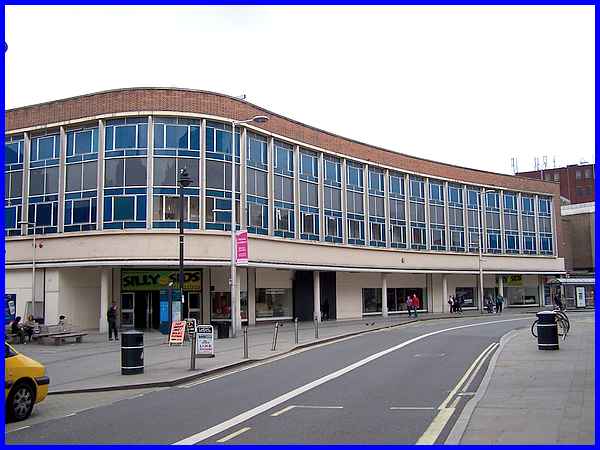
Much of the rest of the south side of Victoria Street was taken
up in 1962 by Ranby's new store replacing their previous premises
(Picture The Past DRBY004339) and the new
building was later occupied by Debenhams (Picture The Past DRBY006263). Since the latter
moved into the new Westfield Centre, the shop on Victoria Street
has acquired a rather forlorn appearance and the name of "Silly
Sids" that is now fixed over the door somehow doesn't portray
the same quality shopping experience as the previous occupants.
|
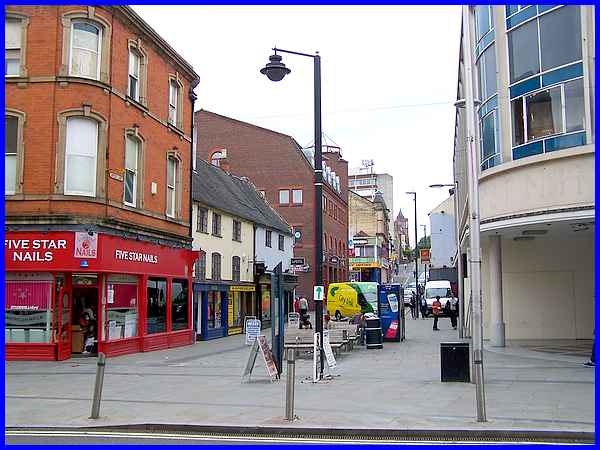
The area between the Ranby's site and the rest of Victoria Street
to the left in this image which dates mostly from the early 1900s
is now pedestrianised but at one time it formed a main route
to Burton On Trent. Called Green Lane and recorded as such in
1510, the name was a descriptive one but now the street is built
up on both sides and the "greenery" for the most part
has disappeared. An old pre-Ranby's picture from 1860 (Picture The Past DMAG300103) shows the south
side of Victoria Street which also contained a number of courts
or yards and the cottages on the left at the bottom of Green
Lane must give an indication of the appearance of the area before
much of the more recent architectural styles appeared on the
scene.
|
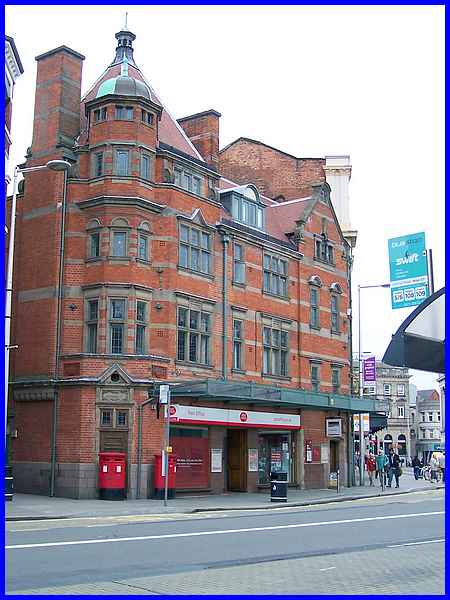
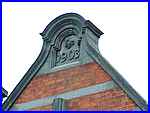 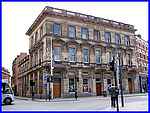 Now turning our attention to the north side of the
street we see Derby's main Post Office. We saw in the previous
part the much larger building of 1865 (left) on the corner of
St James's Street but the Post Office business was transferred
from there to the former Tramway offices (above) in 1997. The
date on the current building being used by the Post Office shows
that it was built in 1903 (right). Now turning our attention to the north side of the
street we see Derby's main Post Office. We saw in the previous
part the much larger building of 1865 (left) on the corner of
St James's Street but the Post Office business was transferred
from there to the former Tramway offices (above) in 1997. The
date on the current building being used by the Post Office shows
that it was built in 1903 (right).
|
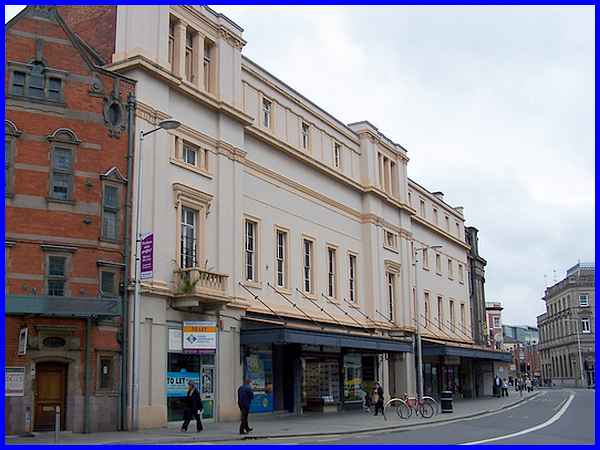
 The rest of
the north side to the Corn Market is taken up by a Grade II Listed
complex constructed between 1837 and 1839 that was built to a
design by Robert Wallace the winner of a competition. The original
design of a Post Office and the Royal Hotel also included the
Athenæum Club which occupied the left hand side of this
frontage. The right hand side in this view was the Royal Hotel
which continued to, and rounded the corner into the Corn Market.
The main entrance to the hotel was actually situated right on
the corner (right) but the hotel closed in 1951 and the building
was then used as Social Security offices. Recently the boarded-up
building has been emblazoned with a yellow "To Let"
sign but the white vans parked outside when I captured these
images suggest that work is ongoing to renovate it. The rest of
the north side to the Corn Market is taken up by a Grade II Listed
complex constructed between 1837 and 1839 that was built to a
design by Robert Wallace the winner of a competition. The original
design of a Post Office and the Royal Hotel also included the
Athenæum Club which occupied the left hand side of this
frontage. The right hand side in this view was the Royal Hotel
which continued to, and rounded the corner into the Corn Market.
The main entrance to the hotel was actually situated right on
the corner (right) but the hotel closed in 1951 and the building
was then used as Social Security offices. Recently the boarded-up
building has been emblazoned with a yellow "To Let"
sign but the white vans parked outside when I captured these
images suggest that work is ongoing to renovate it.
|
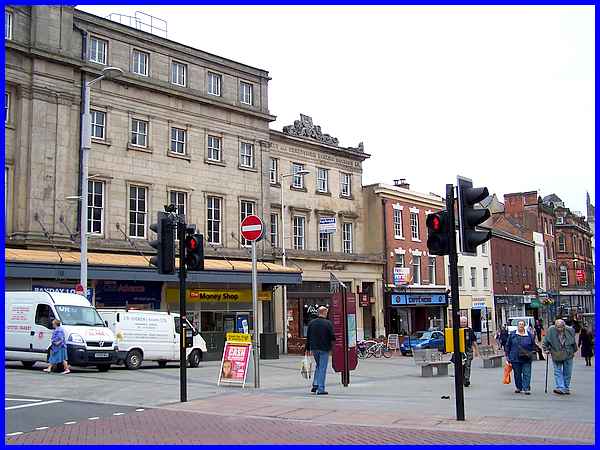
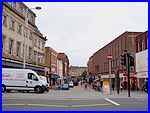 The adjacent
building in the Corn Market is also Grade II Listed and it too
was designed in similar style by Robert Wallace. It still bears
the words "Derby And Derbyshire Banking Company" but
the upper floors like others on this side of the Corn Market
currently also carry "To Let" or "For Sale"
signs. Even with these signs the west side of the Corn Market
is far more attractive than the 1960s store opposite (right).
The Corn Market, first named in 1510, was where grains were traded
and by 1712 had acquired the alternative name of Great Street.
In the eighteenth century grains were displayed in containers
raised on posts (stoops). The adjacent
building in the Corn Market is also Grade II Listed and it too
was designed in similar style by Robert Wallace. It still bears
the words "Derby And Derbyshire Banking Company" but
the upper floors like others on this side of the Corn Market
currently also carry "To Let" or "For Sale"
signs. Even with these signs the west side of the Corn Market
is far more attractive than the 1960s store opposite (right).
The Corn Market, first named in 1510, was where grains were traded
and by 1712 had acquired the alternative name of Great Street.
In the eighteenth century grains were displayed in containers
raised on posts (stoops).
|
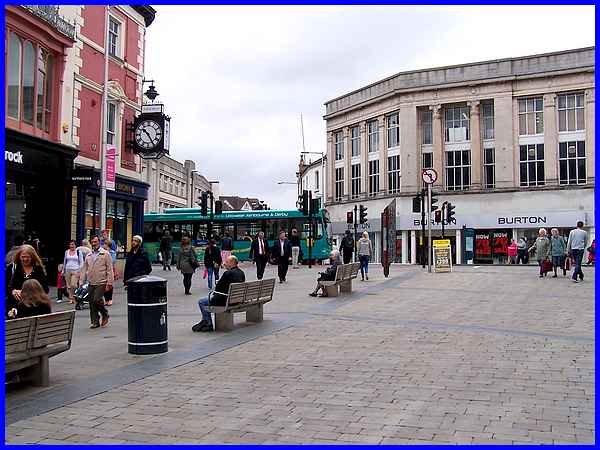
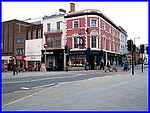  To reduce noise hardwood setts were laid
in 1877 followed by tram lines in 1880. Coming right up to date
the area was pedestrianised in 1991. Standing in the Corn Market
today there is a noticeable rise to Victoria Street for this
is where the Markeaton Brook was crossed by St Peter's Bridge.
Albert Street (right) is a continuation of Victoria Street along
the line of the culverted brook and at the corner is Albert House
(left) which was built in 1848 at the same time as the road construction. To reduce noise hardwood setts were laid
in 1877 followed by tram lines in 1880. Coming right up to date
the area was pedestrianised in 1991. Standing in the Corn Market
today there is a noticeable rise to Victoria Street for this
is where the Markeaton Brook was crossed by St Peter's Bridge.
Albert Street (right) is a continuation of Victoria Street along
the line of the culverted brook and at the corner is Albert House
(left) which was built in 1848 at the same time as the road construction.
|
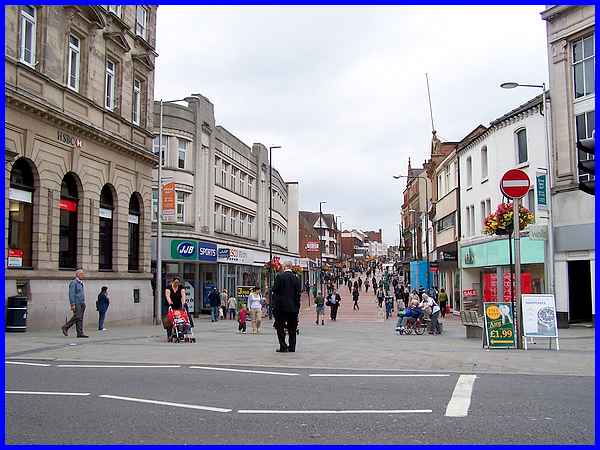
We shall see Albert Street again later in what is becoming a
mammoth walk through Derby city centre but for now our route
will take us across Victoria Street and into St Peter's Street
which was widened in 1871 by demolishing the east (left hand)
side.
|

